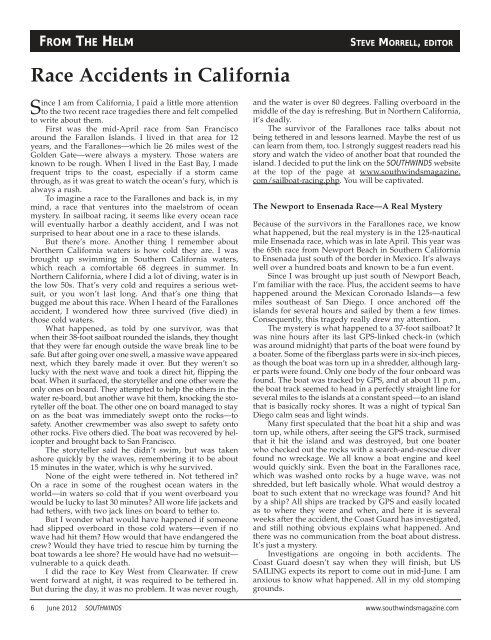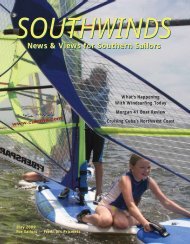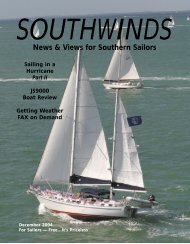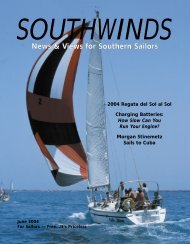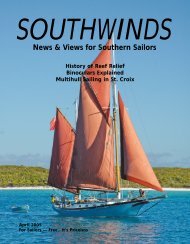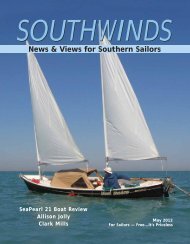Read PDF - Southwinds Magazine
Read PDF - Southwinds Magazine
Read PDF - Southwinds Magazine
- No tags were found...
You also want an ePaper? Increase the reach of your titles
YUMPU automatically turns print PDFs into web optimized ePapers that Google loves.
FROM THE HELMSTEVE MORRELL, EDITORRace Accidents in CaliforniaSince I am from California, I paid a little more attentionto the two recent race tragedies there and felt compelledto write about them.First was the mid-April race from San Franciscoaround the Farallon Islands. I lived in that area for 12years, and the Farallones—which lie 26 miles west of theGolden Gate—were always a mystery. Those waters areknown to be rough. When I lived in the East Bay, I madefrequent trips to the coast, especially if a storm camethrough, as it was great to watch the ocean’s fury, which isalways a rush.To imagine a race to the Farallones and back is, in mymind, a race that ventures into the maelstrom of oceanmystery. In sailboat racing, it seems like every ocean racewill eventually harbor a deathly accident, and I was notsurprised to hear about one in a race to these islands.But there’s more. Another thing I remember aboutNorthern California waters is how cold they are. I wasbrought up swimming in Southern California waters,which reach a comfortable 68 degrees in summer. InNorthern California, where I did a lot of diving, water is inthe low 50s. That’s very cold and requires a serious wetsuit,or you won’t last long. And that’s one thing thatbugged me about this race. When I heard of the Farallonesaccident, I wondered how three survived (five died) inthose cold waters.What happened, as told by one survivor, was thatwhen their 38-foot sailboat rounded the islands, they thoughtthat they were far enough outside the wave break line to besafe. But after going over one swell, a massive wave appearednext, which they barely made it over. But they weren’t solucky with the next wave and took a direct hit, flipping theboat. When it surfaced, the storyteller and one other were theonly ones on board. They attempted to help the others in thewater re-board, but another wave hit them, knocking the storytelleroff the boat. The other one on board managed to stayon as the boat was immediately swept onto the rocks—tosafety. Another crewmember was also swept to safety ontoother rocks. Five others died. The boat was recovered by helicopterand brought back to San Francisco.The storyteller said he didn’t swim, but was takenashore quickly by the waves, remembering it to be about15 minutes in the water, which is why he survived.None of the eight were tethered in. Not tethered in?On a race in some of the roughest ocean waters in theworld—in waters so cold that if you went overboard youwould be lucky to last 30 minutes? All wore life jackets andhad tethers, with two jack lines on board to tether to.But I wonder what would have happened if someonehad slipped overboard in those cold waters—even if nowave had hit them? How would that have endangered thecrew? Would they have tried to rescue him by turning theboat towards a lee shore? He would have had no wetsuit—vulnerable to a quick death.I did the race to Key West from Clearwater. If crewwent forward at night, it was required to be tethered in.But during the day, it was no problem. It was never rough,and the water is over 80 degrees. Falling overboard in themiddle of the day is refreshing. But in Northern California,it’s deadly.The survivor of the Farallones race talks about notbeing tethered in and lessons learned. Maybe the rest of uscan learn from them, too. I strongly suggest readers read hisstory and watch the video of another boat that rounded theisland. I decided to put the link on the SOUTHWINDS websiteat the top of the page at www.southwindsmagazine.com/sailboat-racing.php. You will be captivated.The Newport to Ensenada Race—A Real MysteryBecause of the survivors in the Farallones race, we knowwhat happened, but the real mystery is in the 125-nauticalmile Ensenada race, which was in late April. This year wasthe 65th race from Newport Beach in Southern Californiato Ensenada just south of the border in Mexico. It’s alwayswell over a hundred boats and known to be a fun event.Since I was brought up just south of Newport Beach,I’m familiar with the race. Plus, the accident seems to havehappened around the Mexican Coronado Islands—a fewmiles southeast of San Diego. I once anchored off theislands for several hours and sailed by them a few times.Consequently, this tragedy really drew my attention.The mystery is what happened to a 37-foot sailboat? Itwas nine hours after its last GPS-linked check-in (whichwas around midnight) that parts of the boat were found bya boater. Some of the fiberglass parts were in six-inch pieces,as though the boat was torn up in a shredder, although largerparts were found. Only one body of the four onboard wasfound. The boat was tracked by GPS, and at about 11 p.m.,the boat track seemed to head in a perfectly straight line forseveral miles to the islands at a constant speed—to an islandthat is basically rocky shores. It was a night of typical SanDiego calm seas and light winds.Many first speculated that the boat hit a ship and wastorn up, while others, after seeing the GPS track, surmisedthat it hit the island and was destroyed, but one boaterwho checked out the rocks with a search-and-rescue diverfound no wreckage. We all know a boat engine and keelwould quickly sink. Even the boat in the Farallones race,which was washed onto rocks by a huge wave, was notshredded, but left basically whole. What would destroy aboat to such extent that no wreckage was found? And hitby a ship? All ships are tracked by GPS and easily locatedas to where they were and when, and here it is severalweeks after the accident, the Coast Guard has investigated,and still nothing obvious explains what happened. Andthere was no communication from the boat about distress.It’s just a mystery.Investigations are ongoing in both accidents. TheCoast Guard doesn’t say when they will finish, but USSAILING expects its report to come out in mid-June. I amanxious to know what happened. All in my old stompinggrounds.6 June 2012 SOUTHWINDS www.southwindsmagazine.com


